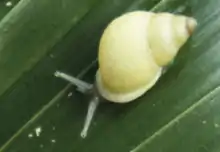Partula (gastropod)
Partula is a genus of air-breathing tropical land snails, terrestrial pulmonate gastropod mollusks in the family Partulidae.[2][3] Many species of Partula are known under the general common names "Polynesian tree snail" and "Moorean viviparous tree snail".[4] Partulids are distributed across 5,000 sq mi (13,000 km2) of Pacific Ocean islands, from the Society Islands to New Guinea.
| Partula | |
|---|---|
 | |
| Partula radiolata | |
| Scientific classification | |
| Kingdom: | |
| Phylum: | |
| Class: | |
| (unranked): | clade Heterobranchia clade Euthyneura clade Panpulmonata clade Eupulmonata clade Stylommatophora informal group Orthurethra |
| Superfamily: | |
| Family: | |
| Genus: | Partula |
Once used as decorative items in Polynesian ceremonial wear and jewelry, these small snails (averaging about one-half to three-quarters of an inch in length) gained the attention of science when Dr. Henry Crampton (along with Yoshio Kondo) spent 50 years studying and cataloging partulids, detailing their remarkable array of morphological elements, ecological niches, and behavioral aspects that illustrate adaptive radiation.[5][6]
Decline
The partulids of the island of Tahiti act as an example of the possible deleterious effects of attempted biological control. After an infestation of the introduced giant African land snails (Achatina spp.), the carnivorous Florida rosy wolfsnail (Euglandina rosea) was introduced into Tahiti in an attempt to combat the African species.
The wolfsnail chose instead to hunt and eat members of the nearly 76 species of Partula that were endemic to Tahiti and the nearby islands, devouring all but 12 species in a decade. Several scientists recognized what was going on, and were able to save 12 species prior to their becoming extinct.
Today, the Zoological Society of London runs the Partula Programme Consortium which maintains a captive-breeding programme in the United Kingdom, France, and the United States.
The 2008 IUCN Red List of Threatened Species contains 15 critically endangered, 11 extinct in the wild, and 48 extinct Partula species.[7] The IUCN Red List of Threatened Species version 2009.2 contains 13 critically endangered, 11 extinct in the wild and 51 extinct Partula species.[8] The IUCN Red List of Threatened Species version 2015-4 contains 83 Partula species.[9]
Species
Species within the genus Partula include: [6]
Ecology
Partula species on Tahiti were usually found on the undersides of the leaves of Caladium and plantain, although in some valleys, they were frequently found on Dracaena and turmeric.[11]
References
This article incorporates public domain text from the reference.[11]
- Férussac A. É. d'A. de (June 1821). Journ. de Physique 92: 460; 1821, H.N. g. et p. Moll., Tabl. Limaçons, 23.
- Myers, P.; Espinosa, R.; Parr, C. S.; Jones, T.; Hammond, G. S. & Dewey, T. A. (2006). The Animal Diversity Web (online). Accessed at http://animaldiversity.org.
- ITIS Standard Report Page: Partulidae
- Searching for "Partula". In: IUCN 2010. IUCN Red List of Threatened Species. Version 2010.3. <www.iucnredlist.org>. Downloaded on 14 September 2010.
- Jung, Younghun, Taehwan Lee, Burch J. B. & Diarmaid Ó Foighil. (2005) "Historical phylogeny of Tahitian Partula". Proc. Joint Conference - American Malacological Society and Western Society of Malacologists.
- Gerlach, J. (2016) Icons of Evolution - Pacific island tree snails, family Partulidae. Phelsuma Press, Cambridge
- IUCN (2008). 2008 IUCN Red List of Threatened Species. <www.iucnredlist.org>. Downloaded on 23 December 2008.
- IUCN (2009). IUCN Red List of Threatened Species. Version 2009.2. <www.iucnredlist.org>. Downloaded on 14 November 2009.
- IUCN (2016). The IUCN Red List of Threatened Species. Version 2015-4. <www.iucnredlist.org>. Downloaded on 07 June 2016.
- Lee, T.; Burch, J. B.; Coote, T.; Pearce-Kelly, P.; Hickman, C.; Meyer, J. Y.; ó Foighil, D. (2009). "Moorean tree snail survival revisited: A multi-island genealogical perspective". BMC Evolutionary Biology. 9: 204. doi:10.1186/1471-2148-9-204. PMC 3087522. PMID 19686604.
- Mayer A. G. (January 1902). "Some species of Partula from Tahiti. A study in variation". Memoirs of the Museum of Comparative Zoölogy XXVI(2), Cambridge, U.S.A.
Further reading
- Crampton H. E. (1916). Studies on the variation, distribution and evolution of the genus Partula. The species inhabiting Tahiti. Carnegie Institution of Washington, 228: 1-311.
- Crampton H. E. (1925). Studies on the variation, distribution and evolution of the genus Partula. The species of the Mariana Islands, Guam and Saipan. Carnegie Institution of Washington, 228a: 1-116.
- Crampton H. E. (1932). Studies on the variation, distribution and evolution of the genus Partula. The species inhabiting Moorea. Carnegie Institution of Washington, 410: 1-335.
- Lee, T.; Burch, J. B.; Jung, Y.; Coote, T.; Pearce-Kelly, P.; ó Foighil, D. (2007). "Tahitian tree snail mitochondrial clades survived recent mass extirpation". Current Biology. 17 (13): R502–R503. doi:10.1016/j.cub.2007.05.006. PMID 17610827.
External links
| Wikimedia Commons has media related to Partula. |
| Wikispecies has information related to Partula. |
Partula evolution, diversity and conservation Partula Pages


